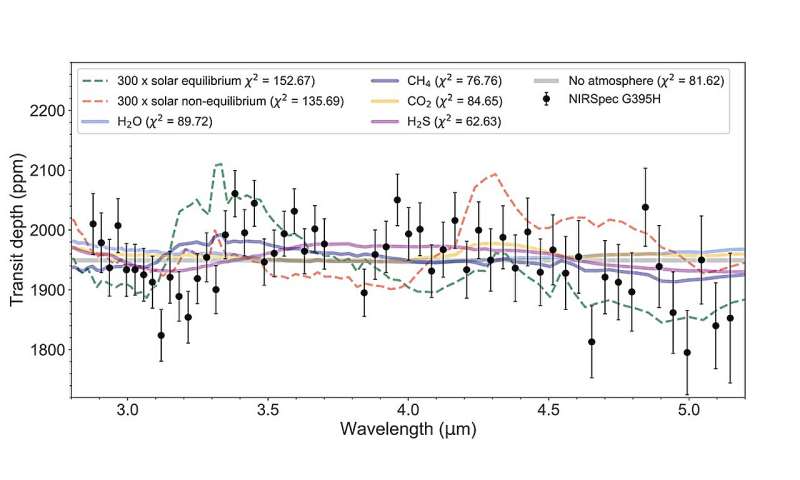September 6, 2024 report
This article has been reviewed according to Science X's editorial process and policies. Editors have highlighted the following attributes while ensuring the content's credibility:
fact-checked
preprint
trusted source
proofread
Nearby super-Earth has a sulfur-rich atmosphere, Webb observations suggest

Using the James Webb Space Telescope (JWST), astronomers from the Space Telescope Science Institute (STScI) in Baltimore, Maryland and elsewhere have conducted transmission spectroscopy of a nearby super-Earth exoplanet known as L98-59 d. Results of these observations, available in a research paper published August 28 on the pre-print server arXiv, suggest that the planet has a sulfur-rich atmosphere.
L98-59 is a bright M-dwarf star located some 34.6 light years away. It is known to be orbited by at least four planets, and one of them is L98-59 d—a super-Earth about 58% larger than the Earth, with a mass of 2.31 Earth masses. L98-59 d orbits its host every 7.45 days, at a distance of approximately 0.05 AU. The planet's equilibrium temperature is estimated to be 416 K.
Given that very little is known about the atmosphere of L98-59 d, a team of astronomers led by STScI's Amélie Gressierof employed JWST's Near Infrared Spectrograph (NIRSpec) to perform transmission spectroscopic observations of this planet. The observations were conducted as part of the JWST Guaranteed Time Observations (GTO) cycle 1 program.
"We presented one transit observation of the super-Earth L98-59 d with the JWST NIRSpec G395H mode," the researchers write in the paper.
By analyzing the obtained data, Gressierof's team found hints of sulfur-bearing species in the atmosphere of L98-59 d. Moreover, hydrogen and helium appear to be background gases in the planet's atmosphere.
According to the paper, the atmosphere of L98-59 d showcases a high abundance of hydrogen sulfide (H2S) and sulfur dioxide (SO2). They excluded the possibility that this could be caused by stellar contamination.
The astronomers note that the presence of sulfur dioxide in the atmospheres of exoplanets like L98-59 d is evidence of photo-chemistry. Furthermore, sulfur species and clouds are generally expected in giant planets and brown dwarf atmospheres. They add that the ability to detect sulfur dioxide in exoplanet atmospheres provides a crucial test for different planet formation models.
Summing up the results, the authors of the paper underline the importance of further transit observations of L98-59 d in order to confirm their new findings.
"If confirmed, the detection of sulfur-bearing species in an hydrogen-dominated atmosphere around L98-59 d, a planet with a radius of 1.58 Earth radii, would be a significant result, as it lies right at the cutoff for planets to have retained their primary hydrogen-helium atmosphere," the scientists conclude.
More information: Amélie Gressier et al, Hints of a sulfur-rich atmosphere around the 1.6 R⊕ Super-Earth L98-59 d from JWST NIRSpec G395H transmission spectroscopy, arXiv (2024). DOI: 10.48550/arxiv.2408.15855
Journal information: arXiv
© 2024 Science X Network





















